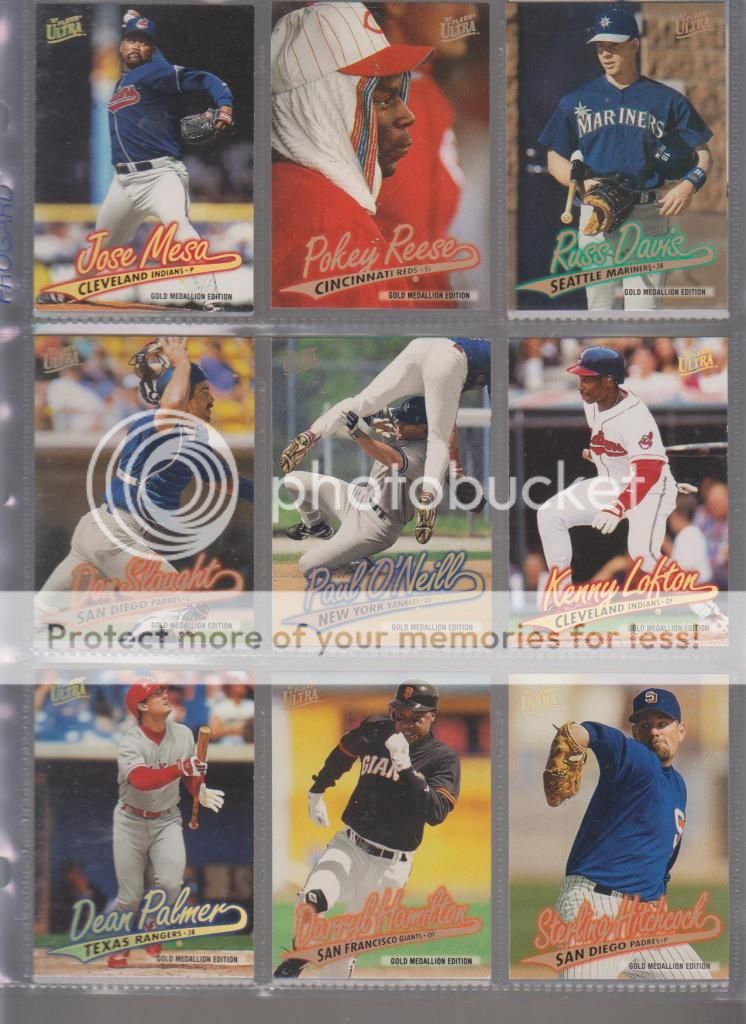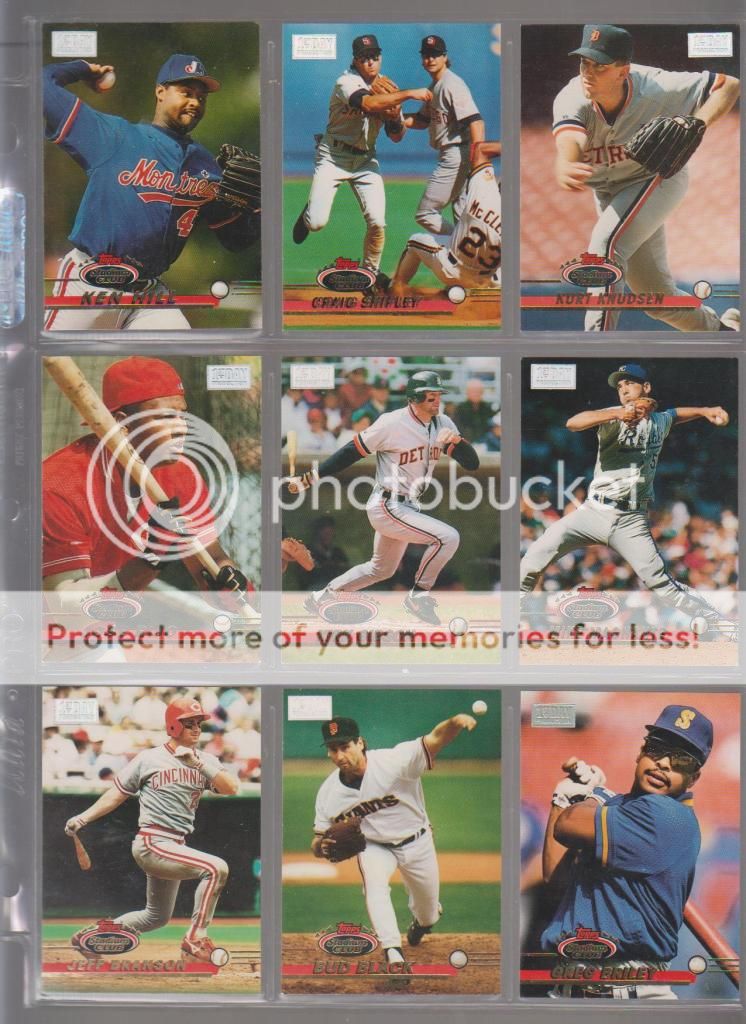
They also had a contest that you could enter to win more gold foiled parallels. Trouble was, the contest was easy to win because of a printing flaw in the contest cards so Topps had to print more gold cards to meet demand. This made a parallel set to their parallel set, and, oh, it was a winner:

Then to perpetuate the madness, Topps took things one step further in 1993 and started to insert the gold foil parallels one per pack:

I never caught parallel fever bad enough to try and build an entire set, but for some reason, I have the first and second series of 1993 represented with pages, maybe it was because two different series were new at the time, I have no idea:

1994 brought more of the same from Topps and their flagship brand:

They added the concept of Black Gold at this point, which I do not have a page of and they weren't parallels but inserts, so let's just look at some more 1994 Gold cards since I once again have a series one page and series two page:

Exhausting? We haven't even started...
Upper Deck, feeling left out, looked at Topps' madness and said "me too!" Their 1993 was almost perfect in every way, including the fact that it did not have parallels. Then in 1994 Upper Deck came up with their Electric Diamond parallels. They weren't gold, they were electric, whatever that is supposed to mean:

That page is ugly in its attempt to be all inclusive. Looking at the aesthetics of that page, I should be ashamed of myself. Upper Deck repeated the Electric Diamond idea in 1995, but the difference was so slight, I have never bothered with a page of them.
One place Upper Deck did get all crazy with the rare metals was with their Collector's Choice set. Starting in 1994, they started with Silver and Gold signature parallels:

The Gold is much more rare than the silver, which I suppose is fitting:

Collector's Choice set had special editions and all sorts of nonsense, keeping it all straight makes my head hurt:



Donruss would eventually take the notion of the parallel farther than anyone, but they started out pretty nice. The 1992 Leaf base set had silver borders, but the parallels were black with gold foil and they look sharp:

The 1994 Donruss base set had a rainbow parallel, which takes shiny to a whole new level:

By the late 90's, the Donruss sets were a horrifying menagerie of parallels, numbered parallels, proofs, artist proofs, die cuts, and the like:




And don't get me started with what they did to the Leaf set. A person could go mad just trying to look up one parallel card from the 1998 Leaf set alone. I have none of those cards represented just to avoid the temptation.
Fleer kept up with the Joneses with their Tiffany parallels:

Their '96 & '97 sets were already a little different in that the base cards were matte finished and the inserts were shiny. In the end, though, their heart just wasn't in it...
But Fleer Ultra had Gold Medallion...and boy, is there gold in them thar cards. Gold medallion over the years varied in it's presentation from full gold:


To hard to tell it's a parallel:

To die cut:

To die cut and golden:

Still with me? Are you paying attention? There will be a written quiz...
Topps eventually branched out from the base set and took parallelitis to its premium set Stadium Club. In 1993, the shiny "1st day issue" block first appeared:

They continued in 1994:

Plus, 1994 also brought some golden rainbow shiny of their own:

1995's Stadium Club parallels combined the then-already worn out phrase "Virtual Reality" and the idea of continuing the 1994 baseball season from where it ended on August 12:

The cards in question featured stats on the back as run through a computer simulation. The 1995 Topps set also had a parallel that hinged on this concept, but you will have to come back on Sunday to see all about that one.
Post script. I just didn't have the energy to do all of Score and Pinnacle and Pacific and go into the late 90's and the numbered parallels of the 2000's....heck, it looks like this will have to become an ongoing series. But believe me, Score was also on the gold bandwagon:

As I have shown with this post, parallels can be quite frustrating, but sometimes, they can almost induce seizure...take these 1997 Score Artist Proofs:

Wow. Just, wow.

2 comments:
The first parallel set I can remember was the 1992 Leaf black border. (Or is '74 Topps minis considered a parallel?)
I still like that set and still pick up a card or two now and then. I'll finish it eventually!
The '90s was pure cardboard excess. I will never understand it.
What's worse is that so many of the parallels back then were so ugly or pointless that you would've had to have been a lunatic to be interested in completing anything. A parallel that is different only because of a silver square? I'll never get why people would be interested in chasing that.
And people think we were weird in the '70s.
Post a Comment